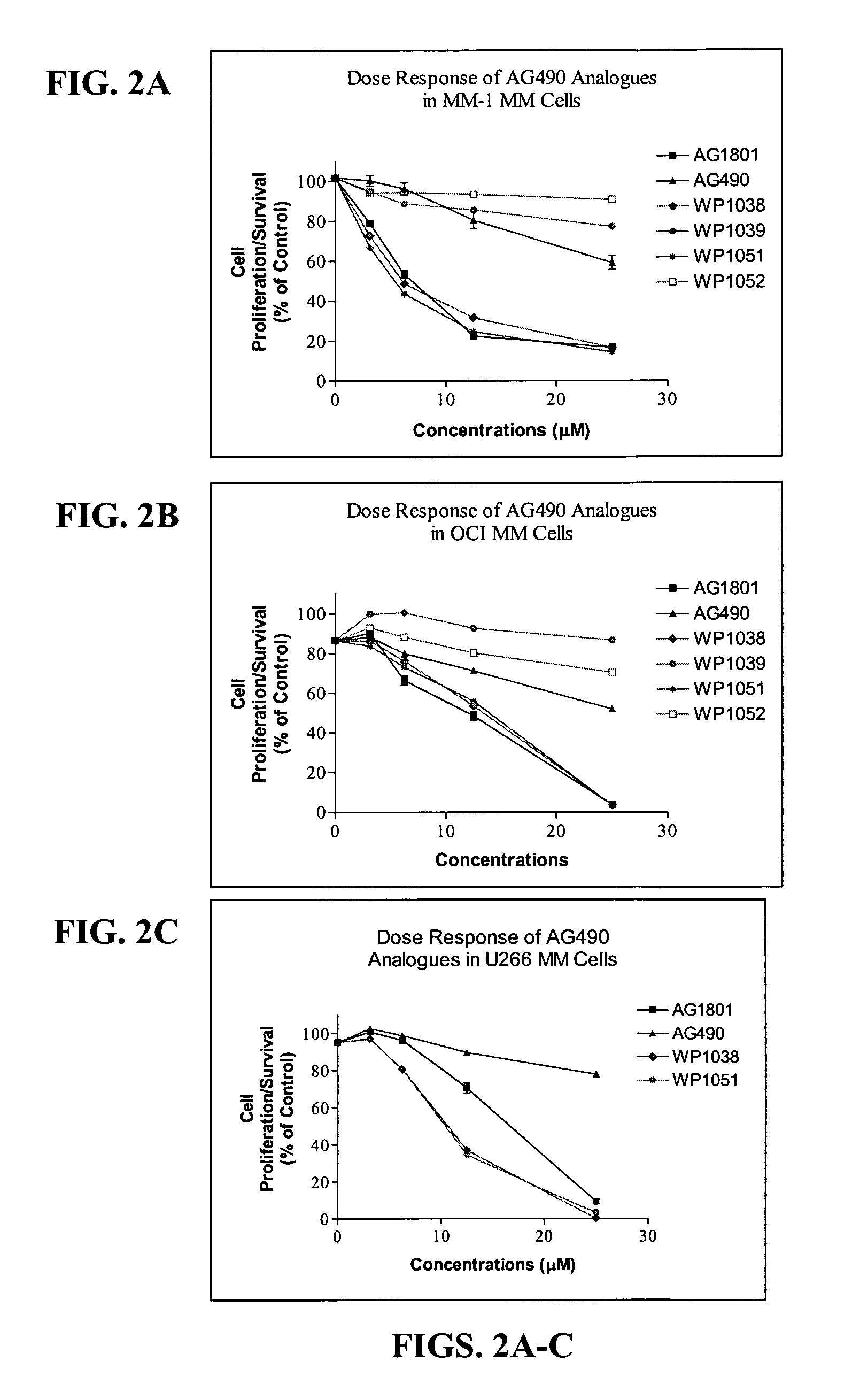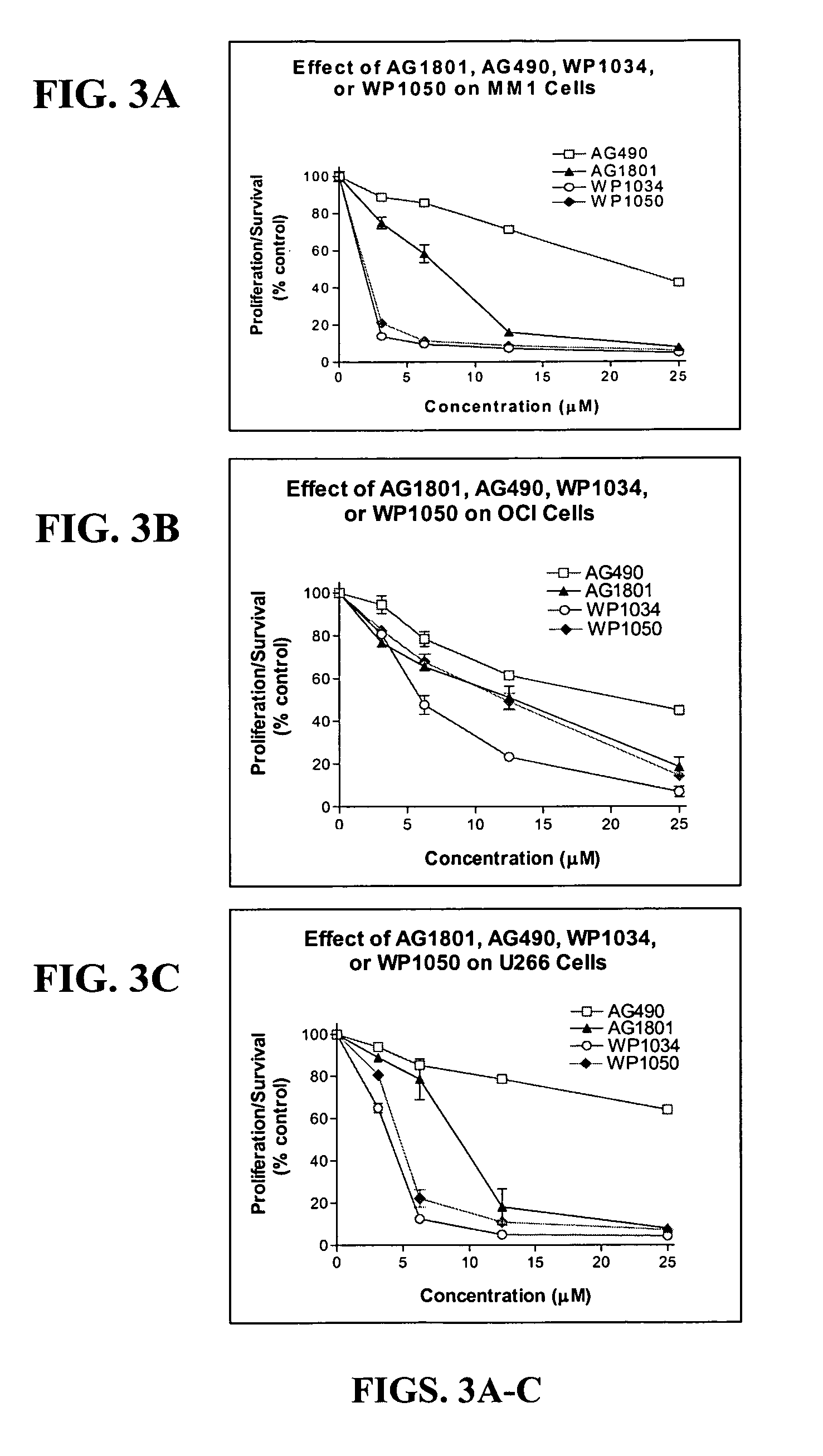Compounds for treatment of cell proliferative diseases
a cell proliferative disease and compound technology, applied in the field of cell proliferative diseases, can solve the problems of limited activity of ag490 and insufficient potency of ag490 to warrant clinical investigation of this compound, and achieve the effects of rapid suppression of the expression of the c-myc proto-oncogene, improved pharmacological profiles, and increased potency
- Summary
- Abstract
- Description
- Claims
- Application Information
AI Technical Summary
Benefits of technology
Problems solved by technology
Method used
Image
Examples
example 1
General Method for Synthesis of Compounds
[0187]N-(Phenylalkyl)cinnamides were prepared by the following general procedure. Benzylamine (3.0 g, 28 mmol) and ethyl cyanoacetate (4.7 g, 42 mmol) in acetonitrile (20 mL) was stirred and reflux for 4 hr. Benzylamine in this general procedure can be replaced by any other substituents depicted as R3 above. The solvent was removed in vacuo to give an oil which solidified upon standing. Precipitation (EtOAc) resulted in 3.28 g (68%) of an off-white powder corresponding to N-benzylcyanoacetamide as an intermediate. A mixture of N-benzylcyanomethylamide (1.3, 7.5 mmol), 3,4-dihydroxybenzaldehyde (1.1 g, 8.2 mmol), and piperidine (catalytic, 5 drops) was stirred at reflux for 3 hr. Flash chromatography (EtOAc) followed by two recrystalizations (H2O / EtOH) yielded product as a white powder 0.8 g (36%).
example 2
Synthesis of Compounds
[0188]Using the protocol detailed in Example 1, the following compounds were synthesized, and data regarding the synthesis of these compounds are presented below.
[0189]AG1801 was synthesized. 1H-NMR (CDCl3, 500 MHz, δ): 8.49 (s, 1H, H-3), 7.39 (d, 2H, J=8.7 Hz, H-3′,5′), 8.12 (d, 2H, J=7.5 Hz, H-2′,6′), 7.43-7.39 (5H, H aromat. from benzyl), 6.75 (bs, 1H, NH), 4.68 (d, 2H, J=5.7 Hz, CH2). Elemental. Anal. Calcd. For C17H13N3O3, Theor. C, 66.44; H, 4.26, N, 13.67. Found: C, 65.70; H, 4.27, N, 13.45. m.p. 165-166° C.
[0190]WP1002 was synthesized. 1H-NMR (CDCl3, 500 MHz, δ): 8.23 (s, 1H, H-3), 7.83 (d, 2H, J=8.6 Hz, H-2′,6′), 7.39-7.28 (5H, H aromat. from benzyl), 6.69 (d, 2H, J=8.6 Hz, H-3′,5′), 6.58 (bs, 1H, NH), 4.62 (d, 2H, J=5.7 Hz, CH2). 4.30 (bs, 2H, NH2)
[0191]WP1003 was synthesized. 1H-NMR (CDCl3, 500 MHz, δ): 8.30 (s, 1H, H-3), 7.92 (d, 2H, J=8.7 Hz, H-2′,6′), 7.71 (s, 1H, NH), 7.66 (d, 2H, J=8.4 Hz, H-3′,5′), 7.42-7.28 (5H, H aromat. from benzyl), 6.70 (b...
example 3
Compounds Display Potent Anti-Cancer Effects
[0243]IL-6 stimulates Stat3 phosphorylation in multiple myeloma (MM) and non-Hodgkin's lymphoma (NHL) cells. In FIG. 1, MM cells (MM-1, 8226, 8226 / S, U266) or NHL (DBr, DB, DS, LP, LR, Mino, MS, FN, Jeko, JM) cells were treated with IL-6 (10 ng / ml) for 10 min before cell lysates were prepared and evaluated for Stat3 tyrosine phosphorylation by immunoblot (anti-pY705-Stat3 from Cell Signaling). IL-6 stimulated Stat3 phosphorylation in all MM cell lines and in 5 out of 10 NHL cell lines (specifically, in DB, DS, LP, FN, and JM cells). It should be noted that U266 cells expressed constitutively activated Stat3 that was further stimulated by exogenous addition of IL-6.
[0244]To examine the effect of newly synthesized AG and WP compounds on cytokine-mediated Stat activation, multiple myeloma (MM-1) cells were pretreated with AG490 or AG1801 at 2.5, 12, and 25 μM concentrations (for 2 hr) before stimulating cells with IL-6 or IFN-α for 10 min. St...
PUM
| Property | Measurement | Unit |
|---|---|---|
| chemical formula | aaaaa | aaaaa |
| concentrations | aaaaa | aaaaa |
| therapeutic concentrations | aaaaa | aaaaa |
Abstract
Description
Claims
Application Information
 Login to View More
Login to View More - R&D
- Intellectual Property
- Life Sciences
- Materials
- Tech Scout
- Unparalleled Data Quality
- Higher Quality Content
- 60% Fewer Hallucinations
Browse by: Latest US Patents, China's latest patents, Technical Efficacy Thesaurus, Application Domain, Technology Topic, Popular Technical Reports.
© 2025 PatSnap. All rights reserved.Legal|Privacy policy|Modern Slavery Act Transparency Statement|Sitemap|About US| Contact US: help@patsnap.com



